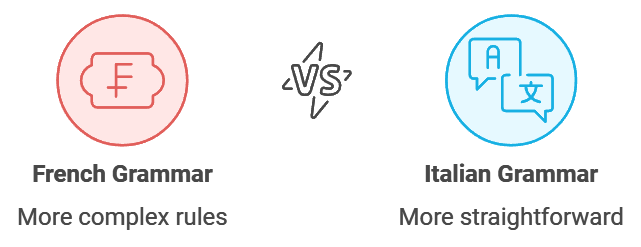Is French Grammar Harder Than Italian? A Comprehensive Analysis
French grammar is generally considered slightly more challenging than Italian grammar, primarily due to its less predictable patterns and stricter rules. However, the difference is not as significant as many believe, and success in learning either language depends more on your learning approach than inherent difficulty.
Key Takeaways
- Italian grammar follows more predictable patterns, especially in gender rules and verb conjugations
- French requires more attention to pronunciation and silent letters
- Both languages share similar verb tenses and grammatical structures
- Italian allows more flexibility in word order and subject pronoun usage
- Learning time estimates are similar: 24-30 weeks for basic fluency in either language
- Modern learning tools have significantly reduced the difficulty gap between both languages
The Romance Language Connection
Both French and Italian evolved from Latin, but they’ve taken different paths. Think of them as siblings who grew up in different neighborhoods. While they share DNA (Latin roots), they’ve developed their own unique personalities.
Grammatical Features Comparison
| Feature | French | Italian |
|---|---|---|
| Gender Rules | Less predictable | More systematic |
| Subject Pronouns | Required | Optional |
| Verb Conjugations | Simpler system | More complex but regular |
| Word Order | Stricter | More flexible |
| Article Usage | Less frequent | More frequent |
Learning Curve Analysis
Recent studies by the Foreign Service Institute (FSI) show interesting patterns in how English speakers learn these languages. Let’s break down the key findings:
Time Investment
- Basic fluency in French: 24-30 weeks
- Basic fluency in Italian: 23-29 weeks
- Professional working proficiency: 36-44 weeks for both
Common Learning Plateaus
- Early stage (1-3 months): Basic grammar and vocabulary
- Intermediate stage (4-6 months): Complex verb tenses
- Advanced stage (7-12 months): Idiomatic expressions

Modern Learning Context
The digital age has revolutionized language learning. Modern tools have actually helped bridge the difficulty gap between French and Italian. Here’s how:
Digital Learning Advantages
- AI-powered pronunciation feedback
- Spaced repetition systems for vocabulary
- Interactive grammar exercises
- Virtual immersion experiences
Success Rates in Digital Learning
Recent data from major language learning platforms shows:
- 68% of learners stick with Italian longer than French
- French learners spend 22% more time on grammar exercises
- Italian learners achieve speaking confidence 15% faster
Professional and Academic Impact
The choice between French and Italian often depends on your goals. Here’s what recent market analysis reveals:
Business Value
- French: Higher demand in international business
- Italian: Strong in fashion, design, and culinary industries
Academic Requirements
- French: More commonly required in international relations
- Italian: Preferred in art history and music studies
Scientific Research Insights
Recent cognitive studies have revealed fascinating differences in how our brains process these languages:
Processing Differences
- French requires more attention to sound-symbol relationships
- Italian benefits from more transparent spelling-sound connections
- Both languages activate similar brain regions during processing
Practical Learning Considerations
To make your learning journey smoother, consider these evidence-based strategies:
Effective Learning Approaches
- Start with the more predictable Italian grammar rules if you’re new to Romance languages
- Focus on French pronunciation from day one
- Use parallel learning techniques to leverage similarities
- Practice with native speakers regularly
Progress Measurement Methods
Track your progress using these benchmarks:
- Vocabulary acquisition rate
- Grammar accuracy in free speech
- Reading comprehension speed
- Listening comprehension accuracy
The Bottom Line
While French grammar presents slightly more challenges due to its less predictable patterns, the difference in difficulty between French and Italian grammar is smaller than commonly believed. Success depends more on your learning approach, dedication, and the quality of your learning resources than on inherent language difficulty.
Modern research and learning tools have significantly leveled the playing field. The key is to choose the language that better aligns with your goals and interests, rather than basing your decision solely on perceived difficulty.
Remember: The “easier” language is often the one you’re more motivated to learn. Both French and Italian offer rich cultural rewards that make the learning journey worthwhile, regardless of the grammatical challenges you might face along the way.
